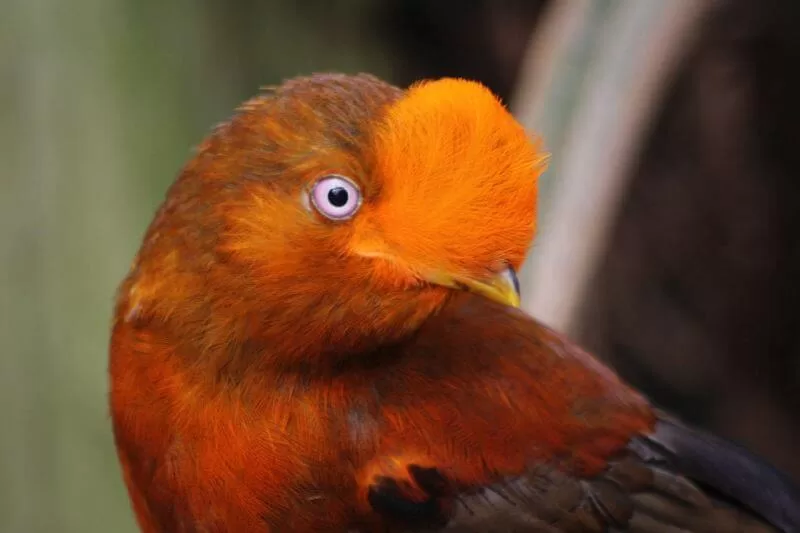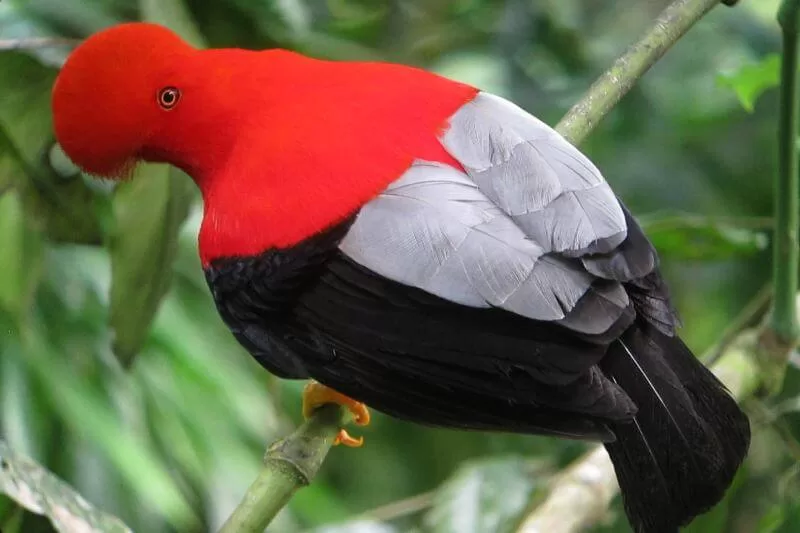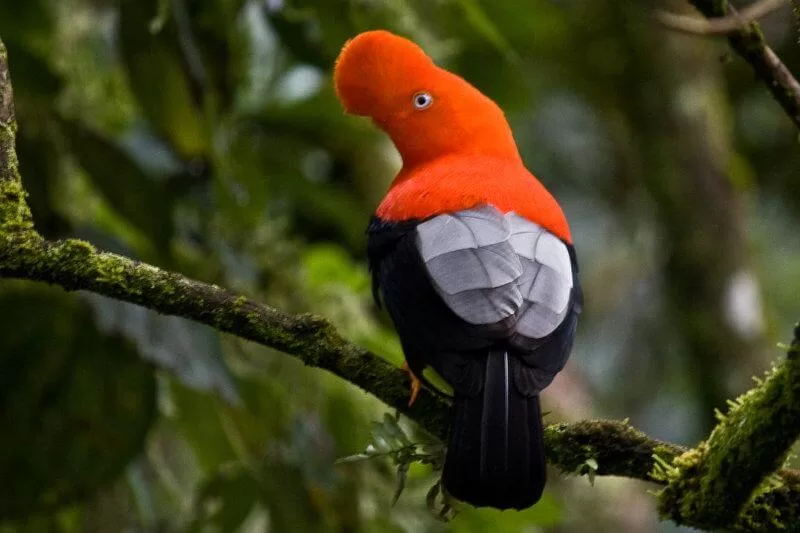The Andean Cock-of-the-Rock (Rupicola peruvianus) is an elusive creature. This vibrant bird is iconic. Its shy nature makes an encounter difficult.
In another post we talked about this incredible bird. So we’ll mainly focus on how to ensure an encounter. Why the cock-of the rock birds are so elusive and more.
Finding the Cock-of-the-Rock requires some extra knowledge. Manu offers several opportunities. This guide will help to increase your chances. We want your adventure in Manu National Park to be complete.

The Cock-of-the-Rock is an endemic bird. Known for its vibrant plumage and the fluffy crest the males have. It’s a remarkable inhabitant of the Manu National park and other places in the Peruvian rainforest.
The Andean Cock-of-the-Rock has a distinctive appearance. Males have a large, fan-shaped crest. Also in males the plumage is bright red and black. Females are duller in color. Its feathers are reddish brown and it lacks the crest.
For mating, males gather in communal display grounds. They perform elaborate displays to attract females. These displays involve vocalizations, jumps, and wing flutters. This is a really weird view.
The Cock-of-the-Rock’s diet focuses on fruits and insects. It plays a crucial role in seed dispersal. This helps maintain and renew the cloud forest. This bird contributes more than is apparent to the health of the ecosystem.
The cock’s nest is quite unique. It builds its nest on rocky outcrops, near streams. This choice provides protection from predators and easy access to resources.
The Andean Cock-of-the-Rock holds the title of the national bird of Peru. It represents the country’s natural resources. It is an example of the diversity of life forms in Peru.
Its image has become recognisable. This bird is an icon of some of the most important conservation zones in the country. You may even see it as part of the representative animals of various districts in the jungle.
Manu National Park also boasts the Andean cock as a inhabitant. Visitors in Manu look for an encounter with this creature. Seeing the Andean Cock-of-the-Rock in its natural habitat is a privilege. It is also no easy task. With proper planning, you can increase your chances.
The Andean cock is the icon of the cloud forest. Its striking appearance makes it a subject for interest. But getting an encounter with this creature is hard.
One reason for this is its habitat preference. The andean cock thrives in dense, humid forests. It obviously preferred inaccessible zones in pristine forest. These environments provide security and food, but it also increases its elusiveness.
Any Cloud Forest is an ideal home for this bird. But most of the area where it is found has an elevation. It also looks for access to rocky ledges for the mating season.
The foliage of its regular home offers excellent camouflage. Finding these birds requires patience and sharp eyes. And you may only be able to catch a quick glance of it on flight.
The Andean Cock-of-the-Rock’s behavior also makes this creature inaccessible. Males gather in leks. In groups, they become an easy target for predators, so they remain hidden. The gathering spots are also hard to locate.
Even the displaying of its mating ritual, gets covered. It involves loud calls and dramatic movements, but still is nos easy to locate. So ensuring an encounter could take time.
Females are even harder to spot. Their more muted colors and shy behavior makes them rare to spot. They regularly keep themselves near the nesting spots. Obviously they evolve these features to avoid predation.
The bird’s activity peaks at dawn and dusk. During these times, visibility in the forest is low. Early risers have the best chance of seeing them.

The Andean Cock-of-the-Rock feeds on fruits high in the canopy. When not in flight, they are really hard to see. Again the forest itself protects them.
Human presence can startle these birds. The andean cock fears humans. They quickly retreat into the dense forest. Observers must move slowly and try to disguise their presence.
The Cloud Forest’s climate does not help either. Frequent rains and mist obscure vision. This bird in particular likes a humid environment full of mist.
Visitors to Manu should consider staying at specialized lodges. Some of them offer visits to confirm nesting sites. Also the staff will be prepared to guide you and support you.
These lodges have commodities like mosquito nets and hot water. You don’t have to suffer in your quest to encounter the national bird. Enjoy a comfortable stay.
Spotting the Cock-of-the-Rock in Manu National Park is a unique experience. After learning some details about it, we can start the plan to encounter it.
First, visit the right locations. The Andean Cock prefers dense, humid forests. Manu National Park offers ideal habitats. But you have to remain focused. Notice the characteristics of the forest, and if there is enough coverage so the cock-of-the-rock feels secure.
Early morning is the best time for sightings. The Cock-of-the-Rock is most active at dawn. Plan your excursions accordingly. Wake up before the daylight breaks to have better chances. Aso consider that you have to arrive before the birds become active.
Join a guided tour. Experienced guides know the bird’s habits and prime locations. They also can help you to get a little closer. They know how to not disturb the bird.
You’ll need a lot of patience. Spend ample time in one spot and observe quietly. You have to make sure you dont stand out. Don’t wear any bright colors. Natural tones that can blend with the environment are the best choice.
Familiarize yourself with the mating calls. You can look for leks ase on sound alone. They are difficult to spot, but the calls can help you identify where they are.
Bring the right gear for your journey. Binoculars and cameras with zoom lenses are essential. You will have to spot this bird from a distance.
Check the weather forecast every day. Some climates not only make walking more difficult. Clear mornings are ideal for birdwatching. Also rain will make the birds go away looking for cover.
Respect the bird’s habitat. Avoid disturbing the environment. Try not leaving traces behind. DO not disturb other fauna. It all is for safety and conservation sake.
Enjoy the overall experience. The Manu Cloud Forest is rich in biodiversity. You can encounter any number of species while exploring. And not only animals. The botanical variety is amazing too.
Spotting the Andean Cock-of-the-Rock is a challenge. With the right approach, you can witness this vibrant bird in its natural habitat. It may take patience and planning. But this is about looking for the best experiences in your next trip to the Manu.

If you got any questions, please do not hesitate to send us a message. We reply within 24 hours!
+51 900 394 399
info@biomanuexpeditions.com
reservas@biomanuexpeditions.com
